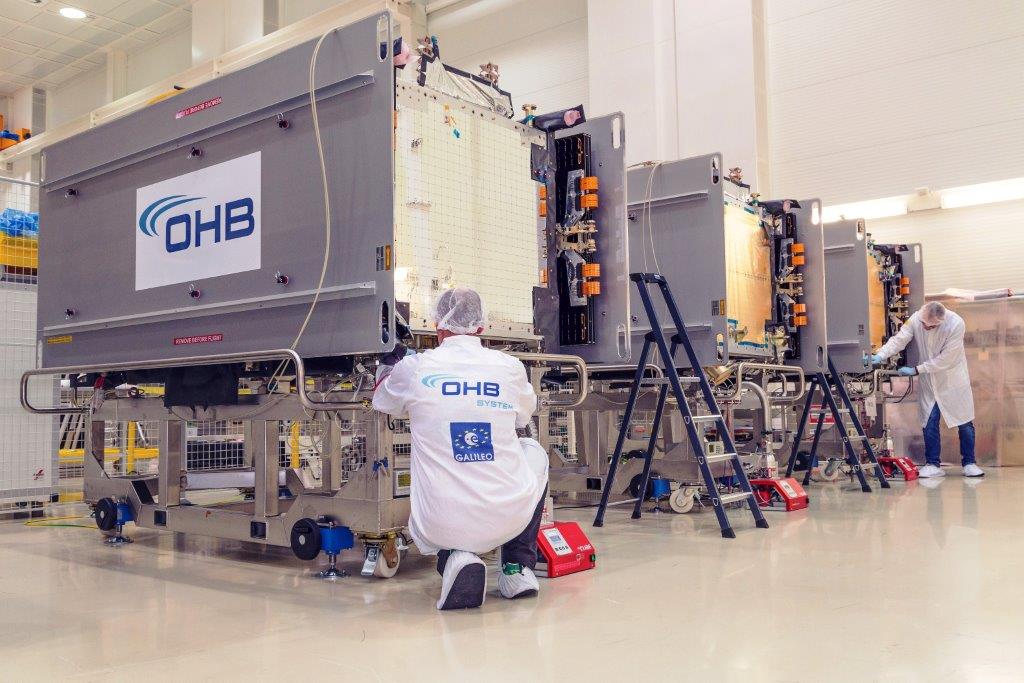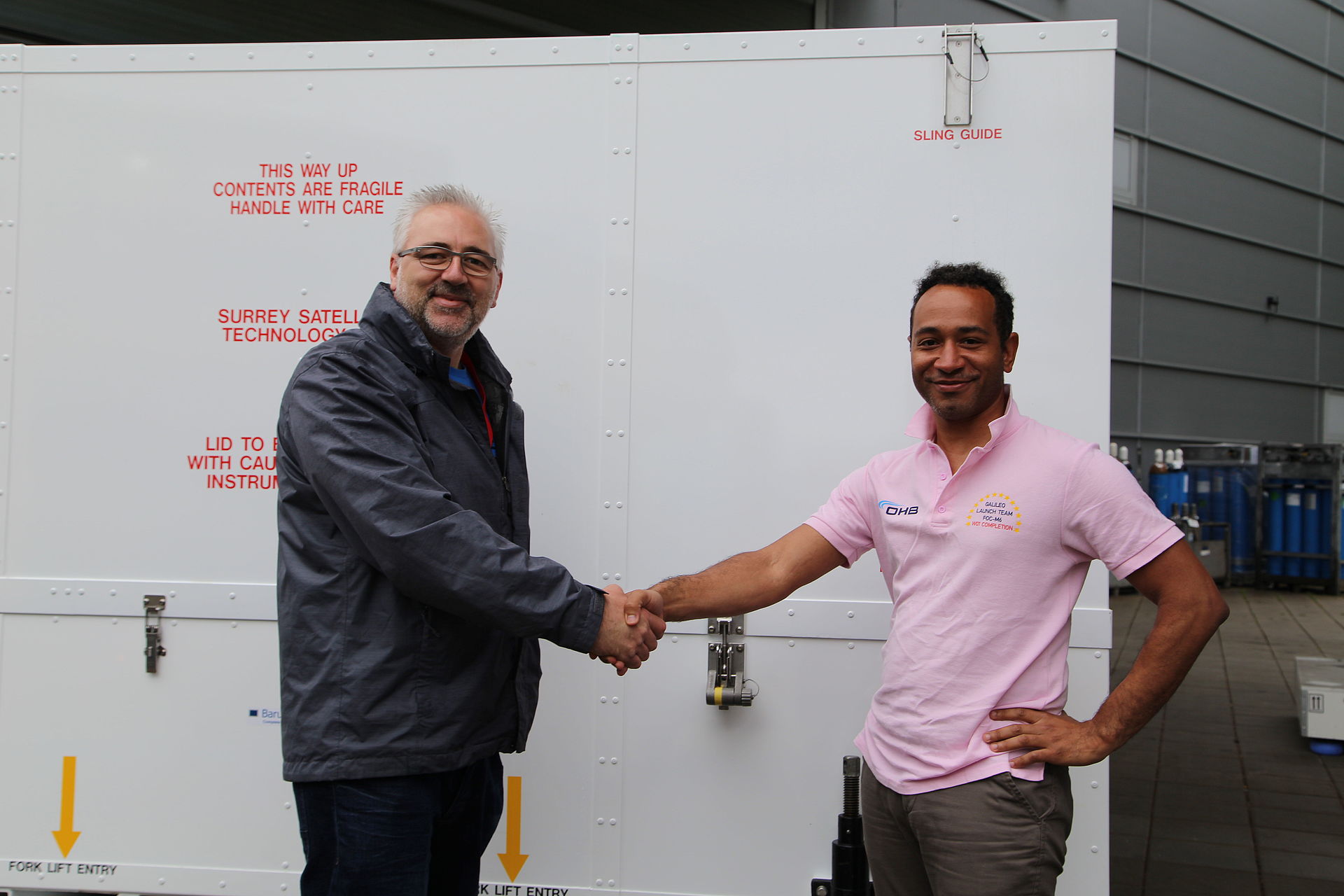Bremen, June 11, 2019. Satellite series production for the European Satellite Navigation System Galileo is in full swing again at OHB System AG in Bremen. The first navigation payload was delivered at the beginning of june by OHB’s partner SSTL according to schedule.
Selected as industrial prime contractor for the space segment by ESA on behalf of the European Commission, OHB System AG will deliver a further twelve satellites for the European Satellite Navigation System Galileo. OHB’s partner SSTL has now handed over the first of the Galileo navigation payloads to be produced under the Batch-3-contract to OHB in Bremen.
“Patrick” going first
The payload will be integrated into its destined satellite platform, “Galileo FOC FM23” which is dubbed “Patrick”. Patrick was the UK winner of a children’s art competition held by the European Commission with the prestigious prize of having one of the Galileo constellation satellites named in his honour.
Payload integration will be followed by a series of comprehensive test activities. “Patrick” and another satellite of this series are scheduled to be ready for launch in autumn 2020.
OHB & SSTL: A proven partnership
Payload integration is of vital importance, both for the entire series production and for every single satellite, since the payload is “the heart” of the satellite. This first payload delivery by SSTL will meet the first platform produced by OHB and both will form the first Batch-3-satellite. “We are looking forward to this first ‘marriage’ of a Batch-3-payload and platform and are ready to start Patrick’s test sequence soon”, says Lars Peters from OHB System AG who is in charge of the Assembly Integration and Test for the satellites at eleven production islands where one satellite is completed every five weeks.
“A total of twelve navigation payloads are being manufactured by SSTL under the Batch-3- contract, with the next shipment due in July”, adds Sophie Bywater, Galileo Programme Manager from SSTL. “SSTL is responsible for the design and construction of the navigation payloads which are based on European-sourced atomic clocks, navigation signal generators and high power traveling wave tube amplifiers”.
Since 2010, the OHB-SSTL partnership has been awarded a total of three contracts, supplying a total of 34 satellites for Europe’s global positioning satellite service.
Shaping Galileo’s future
OHB engineers have long been thinking about sustainable new-generation satellites, since the company intends to continue making a significant contribution to the Galileo system. “Galileo has brought forth a multitude of useful applications for the benefit of citizens in Europe and worldwide”, says Dr Kristian Pauly, Director Navigation at OHB System AG. “We are all keen on contributing our expertise and our experience to the new generation!”
About Galileo
Galileo is Europe’s Global Navigation Satellite System (GNSS), providing real-time positioning, navigation and timing services with unparalleled accuracy and integrity. The satellites support a global Search and Rescue service (COSPAS-SARSAT). Galileo is interoperable with the American GPS system and Russia’s GLONASS system.
Key facts:
-
Galileo satellites have a mass of approximately 720 kg each
-
Operational Galileo FOC satellite launches began in 2014
-
Initial Galileo services went live on December 15, 2016
-
Navigation Services
-
The Open Service (OS) is free for anyone to access. Navigation signals are broadcast in two frequency bands.
-
The encrypted Commercial Service (CS) is available and offers an enhanced accuracy.
-
The Public Regulated Service (PRS) provides an accuracy comparable to the Open Service. The main aim is robustness against jamming and the service is targeted at e.g. security authorities (police, military, etc.) and safety-critical transport applications.
-
The fully deployed Galileo system will consist of 24 operational satellites plus in-orbit spares, positioned in three circular Medium Earth Orbit planes at 23,222 km altitude above the Earth, and at an inclination of the orbital planes of 56 degrees to the equator.
Disclaimer: "The Full Operational Capability phase of the Galileo programme is managed and fully funded by the European Union. The Commission and ESA have signed a delegation agreement by which ESA acts as design and procurement agent on behalf of the Commission. The views expressed in this Press Release can in no way be taken to reflect the opinion of the European Union and/or ESA. “Galileo” is a trademark subject to OHIM application number 002742237 by EU and ESA."

Contact for media representatives:
Marianne Radel
Head of Corporate Communications
Phone: +49 421 2020 9159
Email: marianne.radel@ohb.de
Contact for investors and analysts:
Marcel Dietz
Investor Relations
Phone: +49 421 2020 6426
Email: ir@ohb.de

